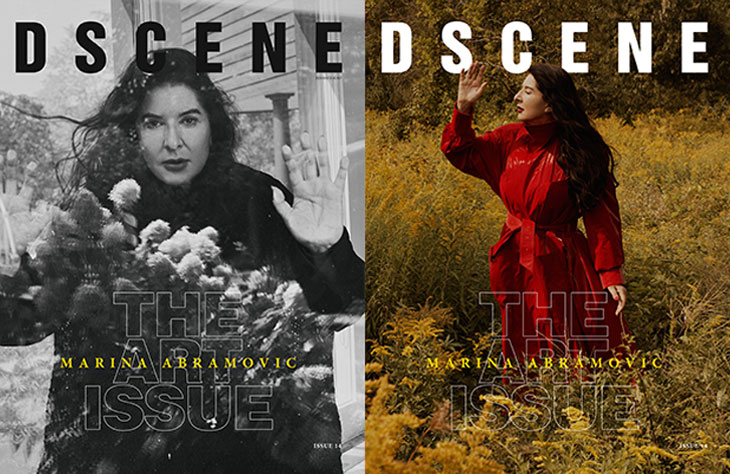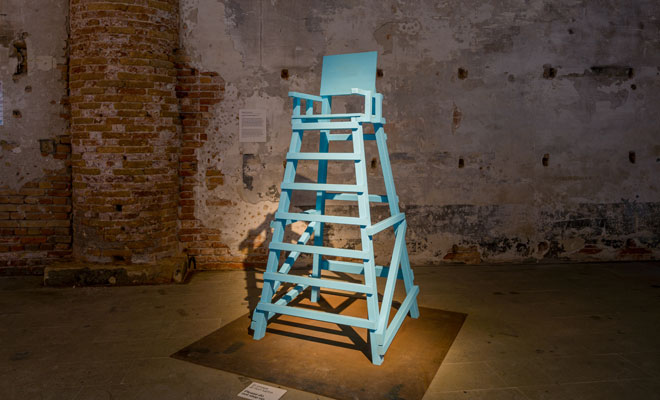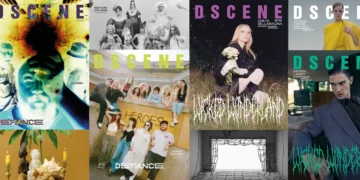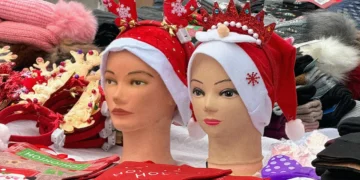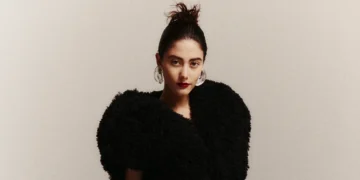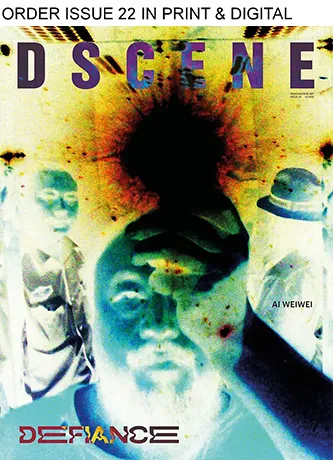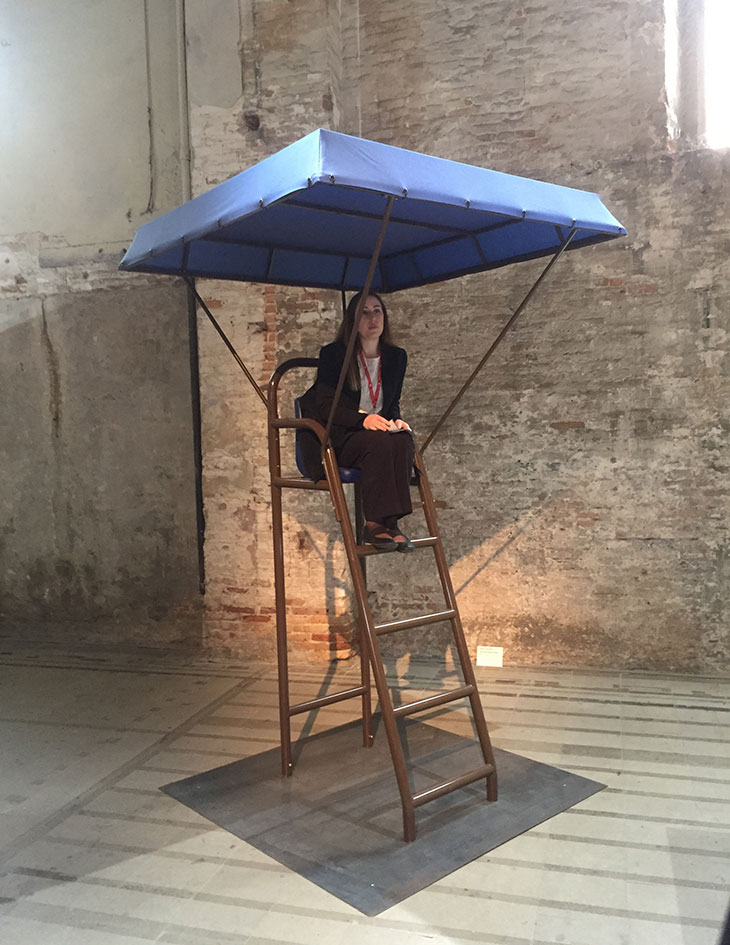
Artist AUGUSTAS SERAPINAS sits down with Guest Editor NATALIJA PAUNIC to talk about his fascination with our relation to spaces surrounding us, his chairs for invigilators at Venice Biennale and our newly found appreciation for “real life” meetings.
DSCENE 014 IN PRINT $12 OR DIGITAL $4.90
Read the interview after the jump:
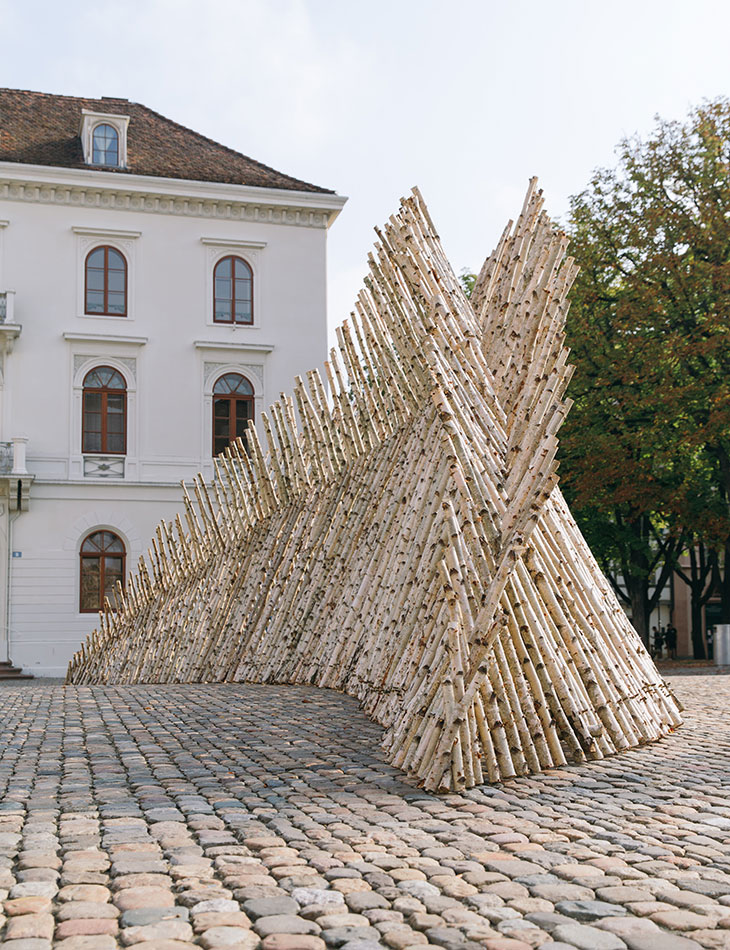
You know, I actually got a degree in architecture before I went into curating. I’m mentioning this because of the connections I feel exist between your work and architecture as a practice, as in, how spaces affect activities. I remember you mentioned in another interview that you’d organized your studio visits in a pipe in Vilnius. How has this changed over time for you? Is that still something you’re thinking about? The pipe was the final work for my BA at the academy. I knew that I didn’t want to do a master course, so I did this work which contained a potentiality to direct my work in a specific way. I think I still believe in that, that spaces affect conversations. How we talk changes, depending on where it happens – in a bar, or a book shop, or a pipe. But in general, for me, it’s about space and how it expresses itself. Architecture is a bit more deliberate, things are done on purpose. The pipe is something that was just left like that. For example, the work I did at Fogo Island was an abandoned house that I knew would disappear, and that’s why I chose it.
In some environments we get more formal, so to speak, than in others. The pipe probably also influences the sound because of the acoustics, right? Anyway, you’re basically looking at the built structures and spaces as found objects? I think the thing with spaces is that you need to find a way to behave, to be in the space – that’s what interests me. That’s different than with objects, they are not as immersive. With objects, you need to immerse yourself. But also, to be honest, this was a very spontaneous interest. In the beginning, I was interested in abandoned spaces, gaps left in infrastructures, unused or semi-used spaces. I started thinking about the “implants” that could be there instead. Kind of like with the human body – it doesn’t really need to be an actual implant, but specific supplements, additions do change the functioning of the body. So I guess in the end, I’m thinking more about the people in the space than the space itself. What they do, what they leave behind.
I’m thinking more about the people in the space than the space itself. What they do, what they leave behind.
Perhaps I have led you astray with this architecture thing a bit. I wasn’t referring to planning or architectural design per se. Right, you meant, architecture as a phenomenon.
Yes, but also as a point of research. Architects often have this fascination with relationships between action and space and how those overlap. Of course, what you’re doing is creating a situation or an installation. Maybe they’re doing the same thing, but with different means. I guess I made the connection because I was thinking about objects as well, which do make most of your body of work, and because of the references you make to habitation. For example, the exhibition in Poland, with the tenant who lived between the galleries. That was my first show abroad, I think. Basically, that was a house built between the two World Wars in Warsaw, by a prominent architect and an academic. After the Second World War, his family moved away to London. When they came back, the building became the state’s property, housing members of the military, and some officers I believe, and their families. After some time, the family reclaimed it, however, there was still one protected tenant living there. His father was a member of the military and he was almost literally born there, in his 50s at that time. He just did not want to move. Anyway, there was a gallery on the ground floor and the second floor, and this guy was living in between, on the first floor, literally between the galleries. I talked to him, even though I don’t speak Polish, but we understood each other in some version of Russian. I asked to borrow his furniture and move it one story down. I think the owner of the house didn’t like that I worked with the neighbor, however.
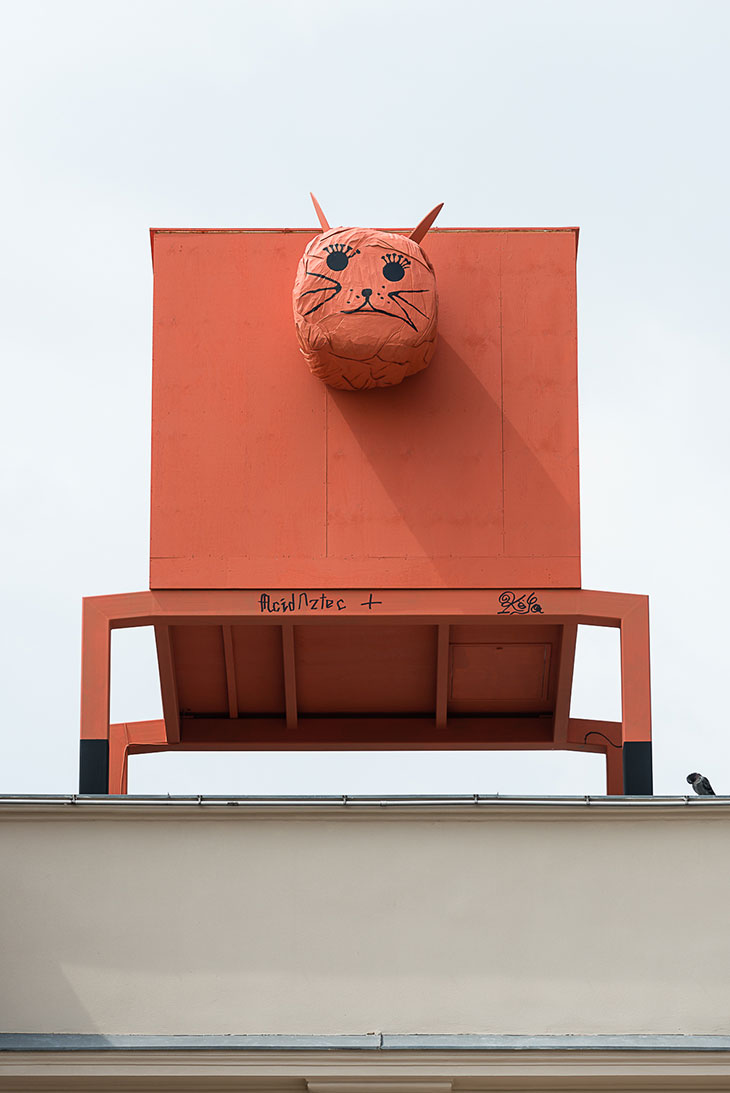
But you were invited to intervene in that particular gallery? It was a duo show, organized by a project space in Lithuania, in exchange with that space in Poland. The other artist brought the work they wanted to show, and I just arrived, with nothing. I sat at a coffee place, thinking, what am I going to do? And I still have that approach. I never know what will really happen. Though, now I do have this sort of scheme: I go to the neighbors. The other thing I do is explore the institutions and people who work at the institutions, and my third point of interest is heritage. Things that could be in museums but they’re not, for example.
This has me thinking about the work from the previous Venice Biennale, the high invigilator chairs – this work referred to a bit of an overlooked member of the institutional structure. I have to admit that I didn’t even see the chairs at first! That space [Arsenale] is very difficult though. Yes, but I also wanted them to really be functional. I wanted the invigilators to be able to sit on them safely, so they couldn’t be made taller than 1.5m, even though I wanted them to be.
Suddenly noticing the things you’re appreciating, the things that are important – that’s a nice thing, a nice quality.
When I went there for the second time, I realized that I actually did see the work, but I thought it was part of the exhibition furniture. So, I think the installation was doing exactly what it was supposed to do. It was mediating something. You could have also passed by and not seen anyone sitting there. There was no schedule or plan, they were just sitting there when they wanted to, and when they were tired. But I guess once they sat, people started to notice them, I mean, they noticed that these people were there. Especially in Venice, it’s hard to notice the invigilators with so many things going on at the same time. And the invigilators usually just stand, they’re not allowed to sit.
How did you manage this with the organization? It just came up. Just like the other work I did, the Nuclear Power Plant with the three kids. Each time we installed it, the kids came with me to do it together. And with the chairs, I don’t really know. I was always interested in the staff that makes the show happen but is somehow in the background, the technicians as well. What was interesting was that, once the invigilators were seated on those chairs, people would actually start to come to them and ask questions.
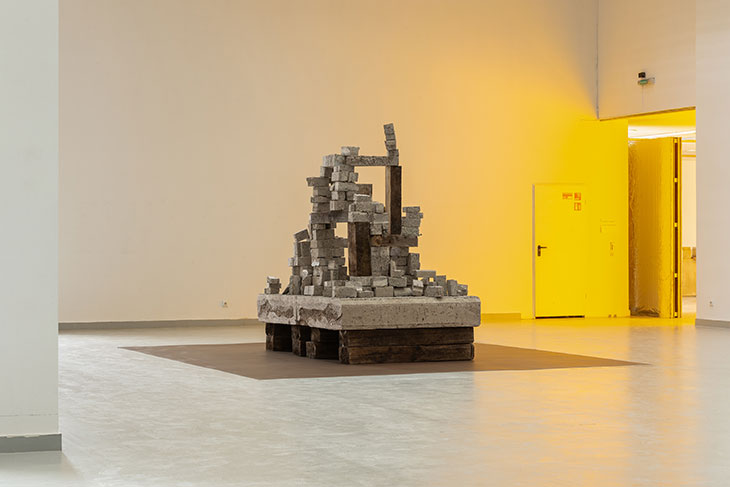
I suppose this elevated position gives them a sort of a different role. I mean, of course, it’s a bit humorous as well. It’s a throne, but not really a proper throne. However, it is allowing them to oversee everything.
Which is basically what they are doing anyway, right? Were the chairs made specifically for the show or were they assembled, ready-mades? Were you researching different types of lifeguard chairs? Yes, they were custom made. I wouldn’t call it research; I was just going through stuff online [laughs]. I did use the proportion I found online, even though there were different designs, depending on the country of origin. There were some really crazy ones in Italy. In Lithuania, we don’t have these chairs, we have cabins.
Speaking of invigilators, neighbors, heritage… My work was always related to them and to sites, thinking about sites and coming back, reacting.
Isn’t it interesting that the Lithuanian pavilion was also concerned with the beach that year? Yeah, it was matching in a way [laughs]. Mine was a bit more spontaneous though, their work existed before.
It’s very special how you’re telling these stories through objects, in their respective contexts. Every work has a story. I have loads of good stories!
Which story comes to mind, with regards to heritage for example, which you mentioned earlier? For example, museum furniture. That furniture itself becomes a heritage of sorts, so placing it alongside an actual display of something that’s, let’s say, a hundred years old, gives it another perspective. Maybe.

Have you already worked with furniture in museums? Not with furniture, but I did make a project for Kunsttage Basel. It’s my latest work. The project originated in Gotland, a Swedish island in the Baltic sea to which I went for an art residency. There is a museum there, which is historical rather than an art museum. They have a collection of various things, bones, sledges, stones, paintings, furniture, and they also display this particular type of fence, a kind you probably won’t find anywhere else. The museum has storage too, in which you can see even more stuff arranged with no particular order or sense – and this storage is not even close to the museum, it’s in another part of the city. When people go out for a smoke there, they are surrounded by some sort of IKEA style fence. My thought was to replace that one with this authentic fence, which could be a display of their heritage. It could also be a sign that this is storage belonging to the museum because otherwise, people don’t even know. But this was postponed.
What happened? I made this sculpture in Basel based on that fence. It’s not a fence anymore, but it is covering a square, so it makes a sort of division. I produced the sculpture in Lithuania, and we shipped it to Basel. Usually, while these things are being built, it’s a sort of gathering that almost turns into a party. That’s how the fence in Gotland was supposed to be built – and this is also part of why it didn’t happen at this time, the pandemic.
So there’s a piece of a story missing because it never materialized. With heritage, in general, I guess, it has its own voice. There could be a story – getting stuff by van, getting across the border, having conversations with the customs [laughs]. I said in the beginning that every work has a story, but in this case, it’s my own entering into an existing story. But, remember the cat from Kunsthalle Wien, for example?
Please remind me, I have dogs from CURA’s space in mind. No, no. This was a cat, Sigi. It was made for How to Live Together, a group show at Kunsthalle Wien. Here’s the story: Sigrid was a chief financial officer over at the Kunsthalle. Some years ago, she found a wooden sculpture of a cat, made by, I think, a first-grade pupil for a school project. It was thrown away, somewhere near a garbage bin. She liked it and picked it up, put it in her office, so it became part of her office. I used it as a model and scaled it up. It became a massive sculpture, and we placed it on top of the building.
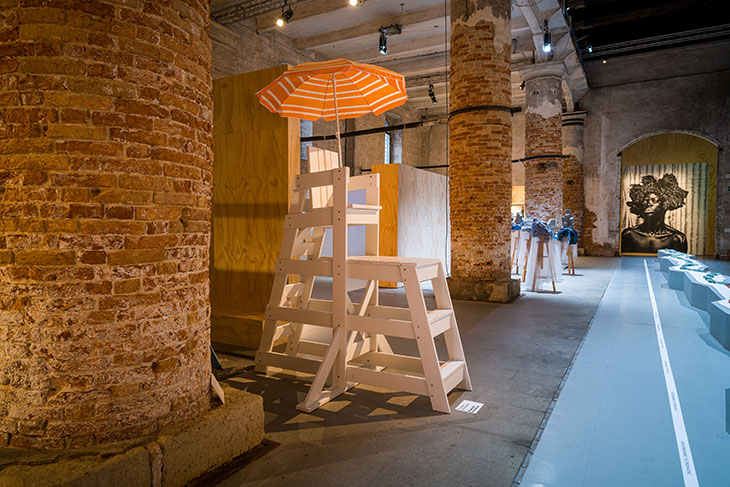
Did the pupil, the girl who made the original, ever see the sculpture? Could you imagine? I was really hoping that she would see it. But I never got any feedback about that.
Have you had any new emotions or ideas on shared spaces or objects, now that we can see them as potentially contagious or dangerous? You know, we are social beings. I think “real life” meetings became far more valuable than before. We didn’t all experience the lockdown in the same way of course, but I think I feel happier when I see people in person now. For me personally, some shows just happened, despite the lockdown, so not too much has changed in that sense. Speaking of invigilators, neighbors, heritage… My work was always related to them and sites, thinking about sites and coming back, reacting. But now after years of doing that, I’m in the stage of making work more independently. I find various ways to work and currently I work in Lithuania. There is, for example, a field of flowers here in an area that is getting gentrified now. I am taking some of them as documentation and working with their pigments for a series of works. To sum it up, the pandemic gives me time to focus on things I can do in Lithuania more.
I like how optimistic you are with everything. This is visible in your work. No depression! [laughs]
I think what I was getting at was that people started being afraid of other people in a way. And you never referred to that. Yeah, we can’t hug anymore. But it’s just because of this situation and I’m sure it will pass. But the creativity that comes out of need is also good, these are the times. Suddenly noticing the things you’re appreciating, the important things – that’s a nice thing, a nice quality.
